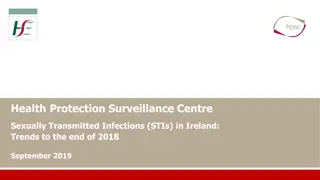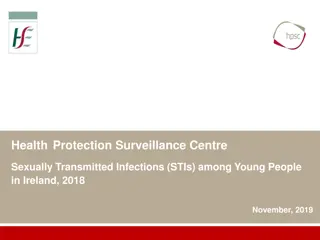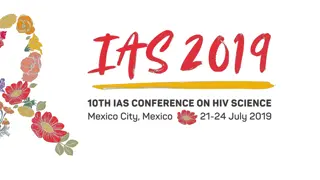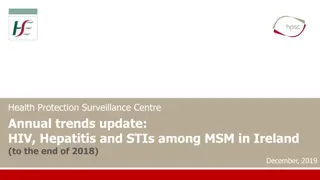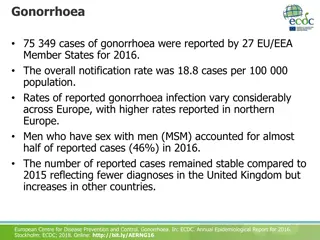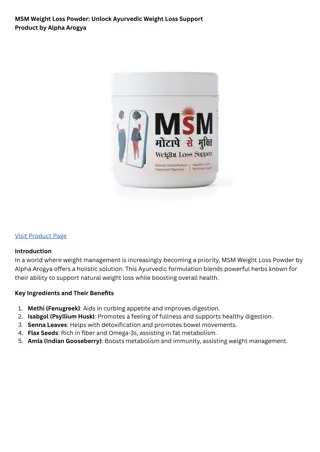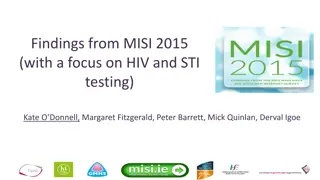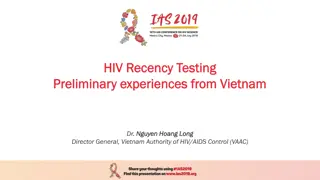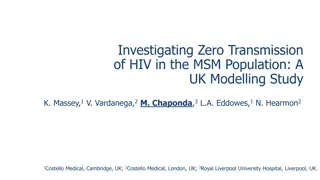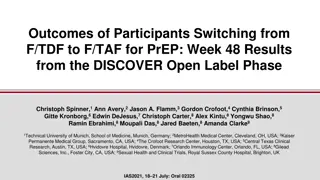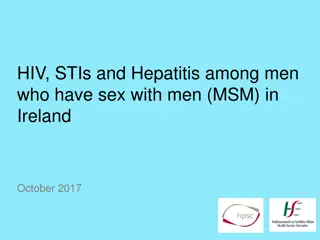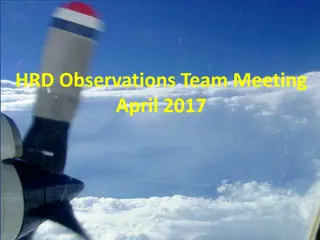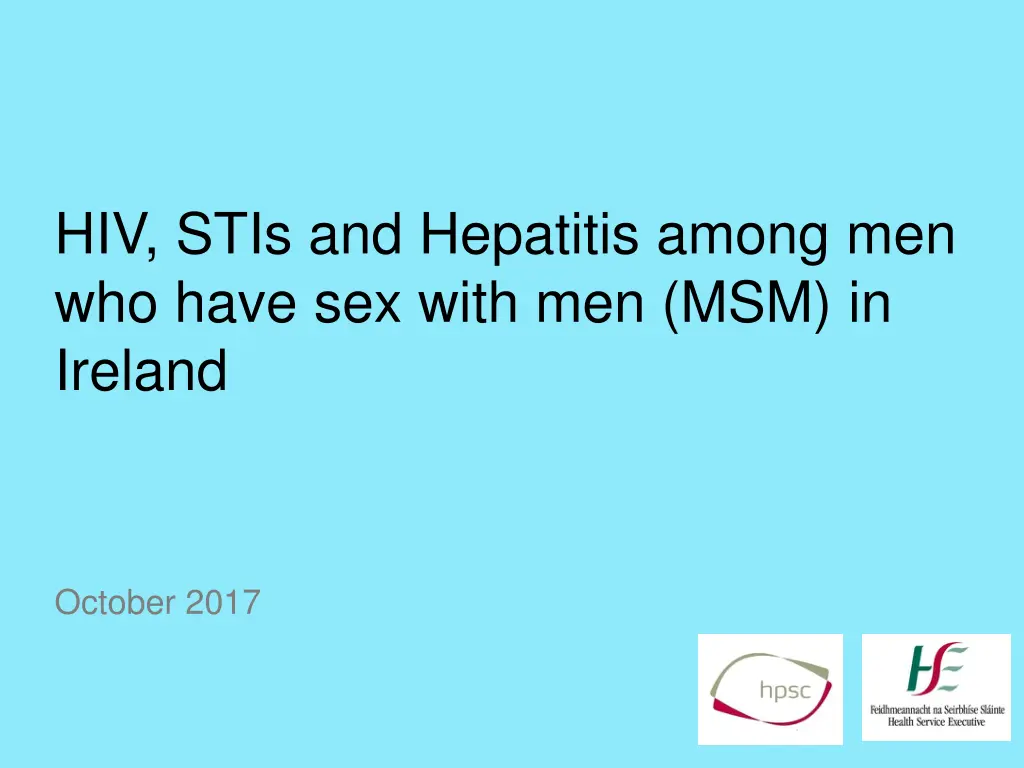
HIV, STIs, and Hepatitis Among Men Who Have Sex with Men in Ireland
Explore data on HIV, STIs, and Hepatitis among men who have sex with men (MSM) in Ireland from October 2017. The notifications of HIV among MSM have increased since 2005, with MSM being most affected by HIV in Ireland. The report highlights a rising proportion of MSM previously diagnosed abroad, impacted in part by changes in case definitions. In 2016, there was a decrease in cases not previously diagnosed abroad, along with a notable increase in notifications from MSM born in Latin America. The summary emphasizes the stability of notifications among Irish-born males in 2017, comparable to the previous year.
Download Presentation

Please find below an Image/Link to download the presentation.
The content on the website is provided AS IS for your information and personal use only. It may not be sold, licensed, or shared on other websites without obtaining consent from the author. If you encounter any issues during the download, it is possible that the publisher has removed the file from their server.
You are allowed to download the files provided on this website for personal or commercial use, subject to the condition that they are used lawfully. All files are the property of their respective owners.
The content on the website is provided AS IS for your information and personal use only. It may not be sold, licensed, or shared on other websites without obtaining consent from the author.
E N D
Presentation Transcript
HIV, STIs and Hepatitis among men who have sex with men (MSM) in Ireland October 2017
HIV 2017 data are provisional
HIV notifications by route of transmission 2003 to 2016 MSM PWID Hetero Unknown 300 250 Number 200 150 100 50 0 20032004200520062007200820092010201120122013201420152016 Year
HIV notifications among MSM by previous history of diagnosis, 2012 to 2016 Previous positive abroad New (not prev positive/unk) 200 180 160 Number of cases 140 120 100 80 60 40 20 0 2012 2013 2014 Year 2015 2016
HIV notifications among MSM by region of birth, 2003 to 2016 Ireland Latin America W Europe C&E Europe S&SE Asia 100 90 80 Number of cases 70 60 50 40 30 20 10 0 2003 2004 2005 2006 2007 2008 2009 2010 2011 2012 2013 2014 2015 2016 Year
HIV notifications among MSM by age group, 2007 to 2016 20-24 25-29 30-34 35-39 80 40-44 45-49 50+ 70 60 50 Number 40 30 20 10 0 2007 2008 2009 2010 2011 2012 2013 2014 2015 2016 Year
HIV notifications among MSM by notification month, Jan 2016 to Sept 2017 60 50 40 Number 30 20 10 0 1 2 3 4 5 6 7 8 9 10 11 12 1 2 3 4 5 6 7 8 9 2016 2017 Year/Month
Summary of HIV data Increasing notifications of HIV among MSM since 2005 MSM are most affected by HIV in Ireland Recently, increasing proportion of MSM were previously diagnosed abroad 16% in 2012 versus 42% in 2016 this has been impacted in part by the change to a more sensitive case definition in HSE East in 2015 and in all other areas in 2016 In 2016, 14% decrease in the number of cases not previously diagnosed abroad, compared to 2015 Steep increase in the number of notifications from MSM born in Latin America while numbers among Irish born have remained stable Notifications of HIV among males in 2017 similar to 2016: approximately 33 per month among males compared to 32
Gonorrhoea 2016 & 2017 data are provisional
Gonorrhoea notifications by route of transmission, 2013-2016 Heterosexual MSM Unknown 900 800 700 Number of cases 600 500 400 300 200 100 0 2013 2014 2015 2016 Year
Rate of gonorrhoea notifications in men and MSM, respectively, per 100,000 population aged 18-64 yrs, 2013-2016 900 800 Rate per 100,000 population aged 18-64 years 700 600 500 400 300 200 100 0 2013 2014 2015 2016 Gonorrhoea MSM Gonorrhoea Male Denominator data: CSO Census 2011 & 2016; MSM = 6% male population
Gonorrhoea: Summary Rate of gonorrhoea notifications among MSM doubled between 2015 and 2016 (from 385/100,000 to 771/100,000). During the same period notifications among males increased by 60% Up to week 39, 2017, there were 1,624 notifications of gonorrhoea compared to 1,382 for the same period last year 81% of cases were among men & 19% among women notifications among males have increased by 7% vs 2016 61% of notifications were among MSM (where mode of transmission is known)
Early infectious syphilis (EIS) 2016 & 2017 data are provisional
Early infectious syphilis notifications by route of transmission, 2012-2016 250 Heterosexual MSM Unknown/Missing Other 200 Number of cases 150 100 50 0 2012 2013 2014 Year 2015 2016
Early infectious syphilis notifications by region of origin among MSM, 2012-2016 Ireland Western Europe C & E Europe Latin America Other Unknown 120 100 80 Number of cases 60 40 20 0 2012 2013 2014 2015 2016
3-week moving average of early infectious syphilis notifications among males, July, 2016 Sept. 2017 12 10 3-wk moving averahe number of notifications 8 6 4 2 0 27 29 31 33 35 37 39 41 43 45 47 49 51 1 3 5 7 9 11 13 15 17 19 21 23 25 27 29 31 33 36 38 2016 2017
Early infectious syphilis: Summary Up to week 39, 2017, there have been 315 notifications of EIS 97% cases were among males (n=305) Median age among males: 34 years (range: 17-71 years) Where mode of transmission is known (n=186; 59%), 91% of cases were among MSM and 8% among heterosexuals (compared to 89% and 11%, respectively, in 2016) 30% of cases among MSM are HIV positive, a reduction compared with 2016 (38%) though the proportion of cases missing mode of transmission is high at 52%
Hepatitis A 2017 data provisional
Hepatitis A Reports of increased numbers of hepatitis A cases in MSM in a number of European countries since mid-2016 3 circulating strains identified through sequencing No cases of hepatitis A identified in MSM in Ireland in 2016 19 cases (37% of all hepatitis A cases) identified January to end Sept 2017 10 infected in Ireland, 6 outside Ireland & country of infection not reported for 3 Age range: 20-42 years, median 32, mean 31.5 32% (n=6) had HIV, gonorrhoea or chlamydia co-infections
Number of hepatitis A notifications, by sex, and % of cases that were male, 2009 to end Sept 2017 60 90 80 51 50 50 50 Number of notifications 46 70 11 38 40 60 36 24 27 % Males 22 50 29 30 16 22 40 21 19 16 20 30 40 11 9 20 26 24 23 10 20 16 10 13 10 10 0 0 2009 2010 2011 2012 2013 2014 2015 2016 2017 (up to end Sept) Year Males Females % Males
Number of hepatitis A cases in MSM notified between January and September 2017 7 Number of notifications of hepatitis A in MSM 6 5 4 7 3 2 4 1 2 2 2 1 1 0 0 Dec Jan Feb Mar April May June July Aug 2016 2017 Onset of symptoms
Hepatitis C 2017 data provisional
Hepatitis C Reports of increased numbers of MSM being diagnosed with hepatitis C since late 2015 8 cases identified as MSM in 2015, 29 in 2016 and 11 in 2017 (up to end September) Age range: 20-61 years (median: 35) 69% HIV positive 70% of HIV positive cases and 40% of HIV negative cases diagnosed with syphilis, gonorrhoea, chlamydia or herpes in same year or year prior to hepatitis C diagnosis
Number of hepatitis C cases identified as MSM, by acute/chronic status, notified between January 2015 and September 2017 7 Number of hepatitis C cases identified as MSM Year and month of notification 6 5 4 3 2 1 0 1 2 3 4 5 6 7 8 9 10 11 12 1 2 3 4 5 6 7 8 9 10 11 12 1 2 3 4 5 6 7 8 9 2015 2016 2017 Acute Chronic Not known
Number of hepatitis C cases identified as MSM, by HIV and recent STI status, notified between January 2012 and September 2017 35 Number of hepatitis C notifications 30 25 identified as MSM 20 15 10 5 0 2012 2013 2014 2015 2016 2017 Year of hepatitis C notification HIV positive & other recent STI* HIV positive, no other recent STI HIV negative/unknown, but had other recent STI HIV negative/unknown and no other recent STI *Gonorrhoea, syphilis, chlamydia, lymphogranuloma venereum or genital herpes simplex in the same year as hepatitis C notification or in the year prior to hepatitis C notification
Acknowledgements We would like to sincerely thank all who provided data for this update; The National Virus Reference Laboratory (NVRL), Microbiology Laboratories, Departments of Public Health, Consultants in Infectious Disease/Genitourinary Medicine, STI clinics, GPs and all other clinicians involved. More detailed reports on HIV and STIs in Ireland can be found at http://www.hpsc.ie/a-z/hivstis/


